Get Started
Wcommerce Blogs
Join Wcommerce’s exclusive webinars to gain expert insights on fitness, wellness, and nutrition. Our sessions are tailored for store owners and fitness trainers, covering the latest trends, product recommendations, and safety practices in the industry. Learn from top professionals and elevate your business and health strategies.
Often called the “miracle tree,” moringa powder is loaded with essential vitamins, minerals, and antioxidants that your body loves. It supports everything from stronger immunity to healthier skin, hair, and nails—making it a true everyday superfood.
Whether you’re just discovering moringa or looking for better ways to use it, this blog will walk you through its top benefits, everyday uses, and even how to make moringa powder at home.
Moringa powder benefits: Why you need it every day
Let’s break down the incredible moringa powder benefits-for your energy, digestion, immunity, and even your beauty routine.
1. Boosts Immunity
Rich in Vitamin C and antioxidants, moringa strengthens your body’s natural defenses and helps fight inflammation and infections.
2. Enhances Energy Levels
Tired of caffeine crashes? Moringa provides a natural energy lift thanks to iron and B-vitamins without the jittery side effects of coffee.
3. Supports Healthy Digestion
Moringa's high fiber content improves gut health, reduces bloating, and keeps your digestive system running smoothly.
4. Balances Blood Sugar
Studies suggest moringa may help lower blood sugar levels due to compounds like isothiocyanates and chlorogenic acid.
5. Detoxifies the Body
Its chlorophyll content helps eliminate toxins and heavy metals from the body, making it an excellent daily detox aid.
Beauty boost: Moringa powder benefits for hair, nails and skin
Yes, this superfood works wonders on the outside too! Here are the top benefits for hair, nails and skin:
Hair:
- Stimulates hair growth with iron and zinc
- Reduces dandruff due to its antimicrobial properties
- Strengthens roots and prevents hair fall
Skin:
- Fights acne and skin infections
- Delays signs of aging with high antioxidant content
- Brightens skin tone and fades blemishes
Nails:
- Prevents brittleness with biotin and calcium
- Improves nail texture and reduces breakage
Add it to your hair masks, face packs, or just drink it daily-your glow-up starts from within!
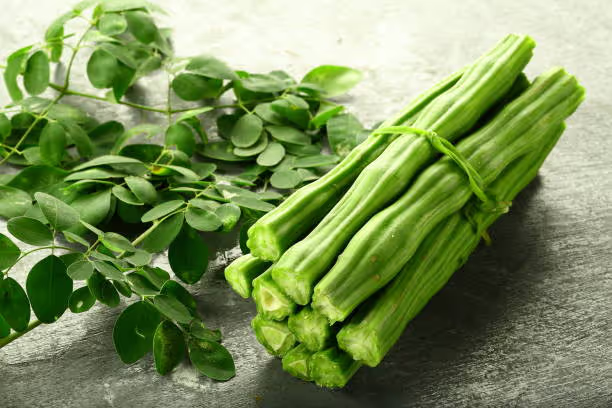
How to make moringa powder at home
If you're wondering how to make moringa powder, it’s easier than you think. Here’s a simple guide:
What you need:
- Fresh moringa leaves (from a reliable source or homegrown)
- A clean drying surface
- Grinder or blender
Step-by-Step process:
- Wash the Leaves
Gently rinse the moringa leaves to remove dirt or bugs. Pat dry with a towel. - Dry the Leaves
Spread them out in a shaded, well-ventilated area. Avoid direct sunlight-it reduces nutrient content. Drying takes 3–4 days. - Grind into Powder
Once completely dry and crispy, grind the leaves into a fine powder using a blender or coffee grinder. - Store in Airtight Jar
Keep it away from moisture and sunlight to retain potency.
Pro Tip:
Use your homemade moringa in smoothies, juices, teas. Knowing how to make moringa powder at home adds a fresh, personal touch to your wellness journey.
Moringa powder vs Other superfoods
Wondering how moringa compares to matcha, spirulina, or wheatgrass?
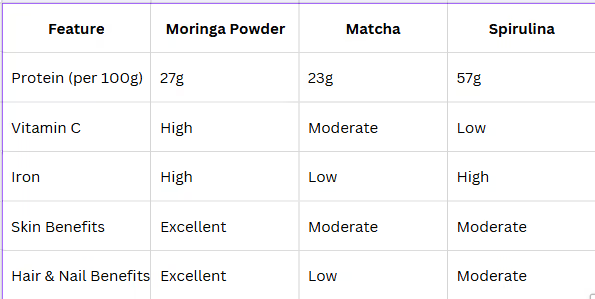
Moringa offers a broader nutrient profile-making it a cost-effective and holistic alternative to many imported superfoods.
Who can use moringa powder?
Moringa powder is safe for most people, including:
- Adults and seniors
- Teenagers
- Vegans and vegetarians
- People with anemia or fatigue
- Skin-conscious and beauty seekers
However, if you're pregnant, breastfeeding, or on medication, consult a healthcare provider before use.
Are there any side effects?
While moringa is generally safe, excessive intake can lead to:
- Upset stomach
- Nausea
- Interference with blood pressure or sugar medications
Stick to 1–2 teaspoons daily, and you’ll enjoy only the positive moringa powder benefits.
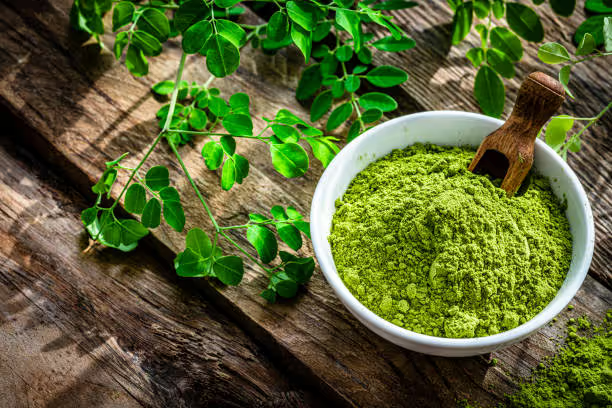
Final thoughts
From your plate to your beauty shelf, moringa powder is a natural multitasker. It boosts energy, supports immunity, and delivers amazing benefits for hair, nails and skin—all from one spoonful a day.
Whether you’re buying it ready-made or learning how to make moringa powder at home, you’re investing in your health and glow.
Sell these products free of cost in your store today
Moringa-based wellness and beauty products are in high demand. Don’t miss the chance to offer them in your online store.
Sell these products free of cost in your store today, open your own store today.
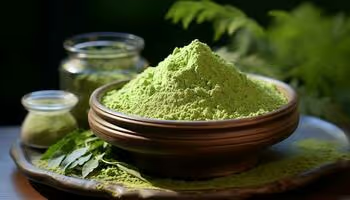
Health Foods
-
8
min read
Discover moringa powder benefits for immunity, energy, and glowing skin. Learn how to use it daily and how to make moringa powder at home.
Dr.Uttara Ghatge, B.D.S
-
July 24, 2025
In a world flooded with processed snacks, refined carbs, and quick-fix health trends, more and more people are pressing pause and returning to nature’s original superfoods. Among these, one humble grain is quietly reclaiming its space on our plates-foxtail millet or कंगनी.
Picture this: generations ago, your grandmother might have cooked hearty meals with foxtail millet, not as a trend, but as a way of life. Today, this ancient grain is making a bold comeback-not just in Indian homes, but across health-conscious kitchens worldwide.
So what makes foxtail millet a superfood in India? For starters, it’s naturally gluten-free, rich in fiber, and packed with essential nutrients. Whether you're managing blood sugar, aiming for better digestion, or just trying to eat clean, foxtail millet checks all the boxes.
In this blog, we’ll walk you through everything you need to know-from foxtail millet benefits and how to cook it, to how it compares with modern favorites like quinoa. If you're ready to bring a little tradition back to your table-with a modern twist-this guide is for you.
What Is Foxtail Millet?
Foxtail millet (Setaria italica), locally known as kangni or thinai, is one of the oldest cultivated millets in the world. Grown widely in India and parts of East Asia,this tiny yellow grain is packed with nutrients and free from common allergens like gluten.
Millets were once a poor man's staple but have now found their way into gourmet kitchens and health stores thanks to their dense nutritional profile and low environmental impact. Foxtail millet, in particular, stands out because of its high protein content,slow-digesting carbs, and rich fiber levels.
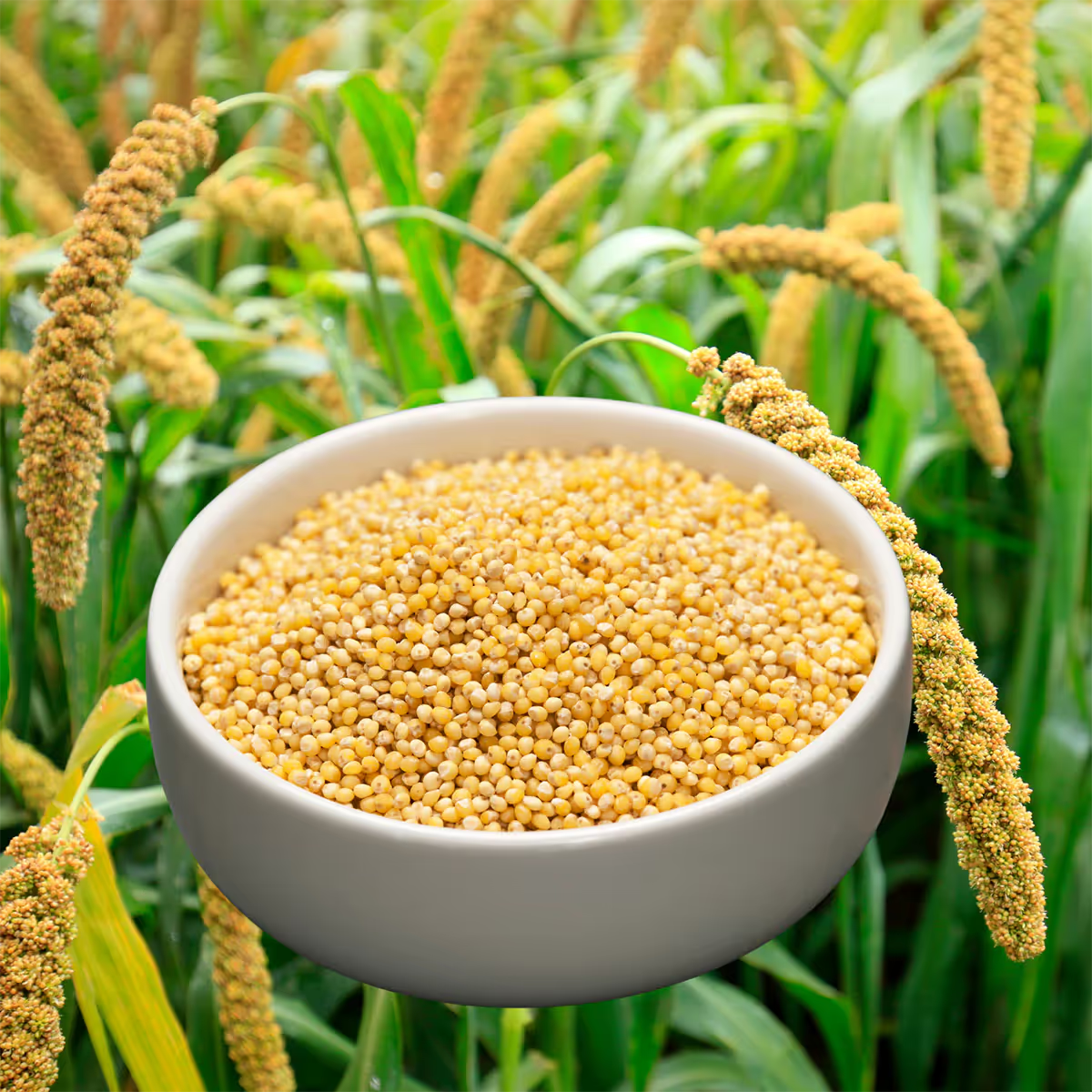
Top Foxtail Millet Benefits
Switching to foxtail millet can bring several long-term health advantages. Here are some of the major foxtail millet benefits that make it a superfood:
1. Supports Weight Loss
Foxtail millet is rich in dietary fiber and complex carbs that keep you full for longer. This helps reduce cravings and lowers your overall calorie intake-making it ideal for those on a weight loss journey.
2. Controls Blood Sugar Levels
The grain has a low glycemic index, which means it releases sugar slowly into the bloodstream. This makes it excellent for people with diabetes or those trying to manage insulin spikes.
3. Improves Heart Health
Foxtail millet contains magnesium and other essential nutrients that help lower bad cholesterol (LDL)and improve heart function.
4. Boosts Digestive Health
Its high fiber content promotes gut health, aids digestion, and prevents constipation. This makes it especially useful in urban diets lacking in roughage.
5. Strengthens Bones and Immunity
With good amounts of iron, calcium, and antioxidants, foxtail millet plays a role in strengthening bones and boosting the immune system.
Is Foxtail Millet Gluten-Free?
Yes, it is! Foxtail millet is naturally gluten-free, which makes it a smart and safe choice for people with celiac disease or gluten sensitivity. Unlike grains like wheat, barley, or rye, foxtail millet doesn't contain the proteins that trigger allergic reactions or digestive issues in gluten-intolerant individuals.
It’s a versatile grain you can easily use in place of wheat or rice-whether in baking, porridges, or even in your daily meals. Best of all, you won’t be missing out on nutrition. Foxtail millet delivers fiber, protein, and key minerals-minus the gluten.
Is Quinoa a Millet?
It’s a common mix-up—but no, quinoa is not a millet.
Quinoa is actually a pseudocereal—it’s not a true grain, but it behaves like one when cooked. It comes from the Chenopodium plant and is native to South America. Millets, on the other hand, are true cereal grains, traditionally grown across Asia and Africa.
The difference between quinoa and millet lies in their origin and classification: quinoa is a seed from a broadleaf plant, while millets are small-seeded grasses.
While both quinoa and millets are gluten-free, nutrient-dense, and versatile, millets have a key edge-especially in India. They’re locally grown, more climate-resilient, and a budget-friendly superfood.
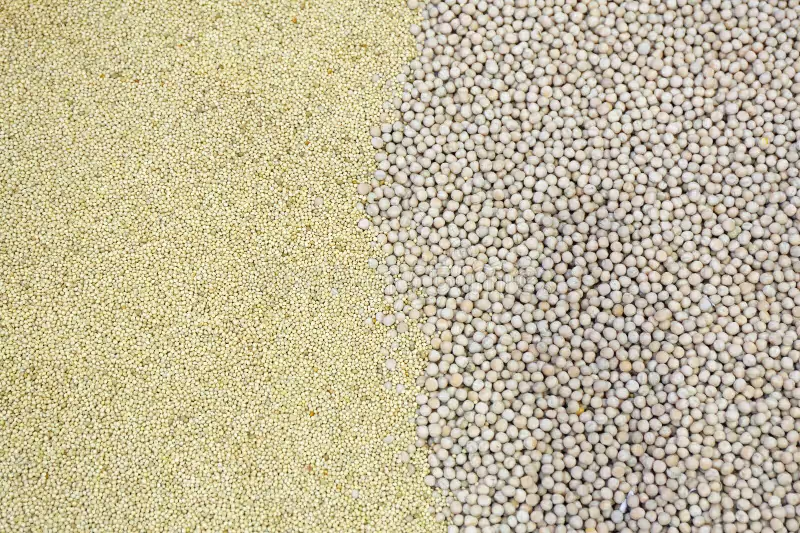
How to Cook Foxtail Millet: Easy Recipes & Tips
If you’re new to millets, don’t worry-learning how to cook foxtail millet is super simple. The grain is quick to prepare, versatile, and adapts well to both traditional and modern recipes.
✅ Basic Cooking Instructions
Ingredients
- 1 cup foxtail millet
- 2.5 cups water
- A pinch of salt (optional)
Steps:
- Rinse the millet 2–3 times to remove dust and impurities.
- Soak it for 15–20 minutes to reduce cooking time and improve texture.
- Boil water in a pot, add the millet and salt, then reduce heat and cook covered for 10–12 minutes.
- Let it sit for 5 minutes and fluff with a fork before serving.
✅ Recipe Ideas
- Foxtail Millet Upma: Replace semolina with millet for a fiber-rich breakfast.
- Foxtail Millet Idly/Pongal: A twist on the traditional South Indian dish with added lentils.
- Foxtail Millet Salad: Toss cooked millet with veggies, lemon juice, and olive oil.
- Foxtail Millet Khichdi: Use it instead of rice with moong dal and mild spices.
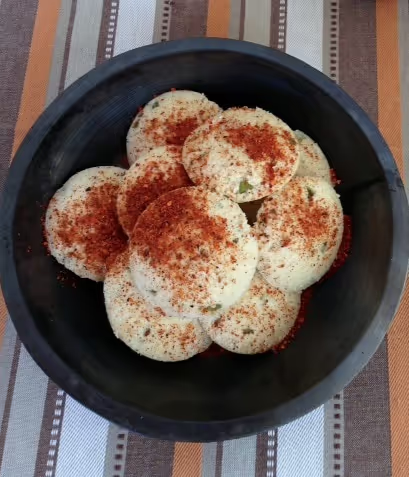
Why Foxtail Millet deserves a spot in your pantry
Foxtail millet isn’t just another health trend-it’s a smart, sustainable lifestyle choice. Here’s why it deserves a permanent place in your kitchen:
- Easy on the wallet and easy to find: It’s affordable and grown locally, making it a great alternative to expensive imported grains.
- Eco-friendly by nature: Foxtail millet requires less water, fewer fertilizers, and thrives in dry conditions-making it a win for both your plate and the planet.
- Long shelf life, quick cooking: It stores well without preservatives and cooks faster than many other whole grains, saving you time in the kitchen.
- Culinary chameleon: From fluffy rotis and crispy dosas to soothing porridges and grain bowls, foxtail millet adapts to almost any recipe.
It’s wholesome, versatile, and good for both you and the earth-what’s not to love?
Pro Tips for storing and using Foxtail Millet
- Store it in an airtight container in a cool, dry place.
- Dry roast millet before cooking for a nutty flavor.
- Mix with other millets for variety and added nutrition.
- Use it in desserts like millet laddoos or kheer.
Final Thoughts
Foxtail millet is more than just a food trend-it’s a return to our roots and a smart move towards better health and sustainability. From reducing lifestyle diseases to enhancing daily nutrition, this supergrain checks all the boxes.
Whether you're a health enthusiast, a home chef, or a retailer—now is the best time to embrace foxtail millet.
Create your store today and take your business to the next level with Health foods that you, your customers & your health will love! Join thousands who are creating their stores and selling products like these to earn an income or to buy products at wholesale prices for themselves, friends and family.
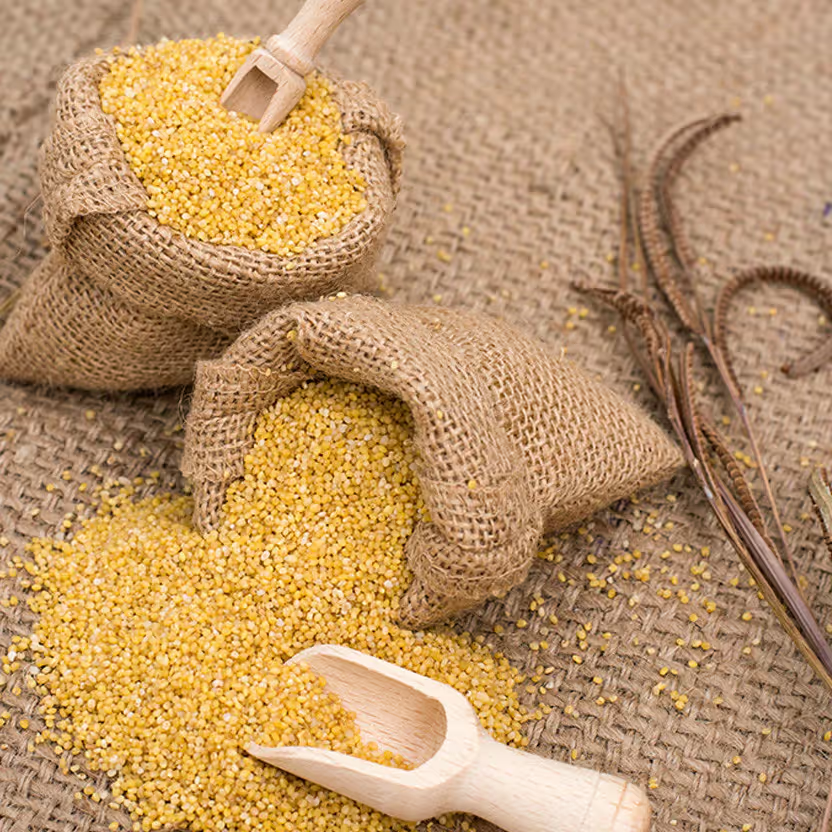
Health Foods
-
8
min read
Foxtail Millet: High-protein gluten-free supergrain
Foxtail millet is a gluten-free, protein-rich supergrain ideal for weight loss, diabetes and heart health. Add it to your daily meals for better health.
Dr.Uttara Ghatge, B.D.S
-
July 15, 2025
Limited Time Offer: Free lifetime access
Create your store with Wcommerce today and enjoy a zero subscription fee forever. Don't miss this exclusive opportunity to maximize your earnings without any monthly costs.
Launch your store and start selling in 3 minutes
Get Started
+

Great!
You have reserved a store.
Our team will reach out to you shortly.
Our team will reach out to you shortly.
OK
Oops! Something went wrong while submitting the form.